- Calendar
- Online Ticket Sales
- Access
- JA
- EN
Daigoji Temple: A Shingon Esoteric Buddhist Universe in Kyoto
September 19 to November 11, 2018
*There will be an exhibition change during the course of exhibition
*This exhibition will travel to Kyushu National Museum (January 29 to March 24, 2019).
*Download the list of changes in works on display
The list of changes in worksPDF
Section 1
Shōbō and the Founding of Daigoji
After studying various Buddhist traditions at Tōdaiji temple, the monk Shōbō (832-909), who was a descendant of Emperor Tenji, discovered a spring whose water had the most marvelous flavor (Jpn. daigomi) on Mt. Kasatori. It was in the year 874 (Jōgan 16) during the Heian period. Shōbō, who was later known as Rigen Daishi (Great Master Rigen), built his quarters on the mountain and installed images of Juntei (Skt. Cundī) and Nyoirin (Skt. Cintāmani-cakra), esoteric varieties of the bodhisattva Kannon (Skt. Avalokieśvara), there. This marks the beginning of Daigoji temple.
The temple later garnered the faith of Emperor Daigo and succeeding emperors, and within a few decades of its founding, the Yakushidō (Hall of Bhaiṣajyaguru) and the Godaidō (Hall of the Five Great Divinities) were built one after another on the site. The appearance of the temple gradually began to take shape.
This section of the exhibition provides an overview of the period of the temple’s founding based on the legend of Daigoji’s origins and portraits and the biography of Shōbō.
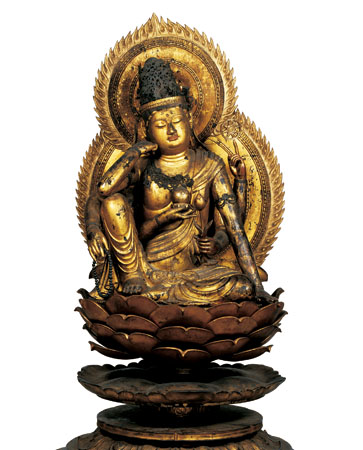
Heian period, 10th century
(Picture provided by Nara National Museum, Photo by Kinji Morimura)
【To be shown over an entire period】
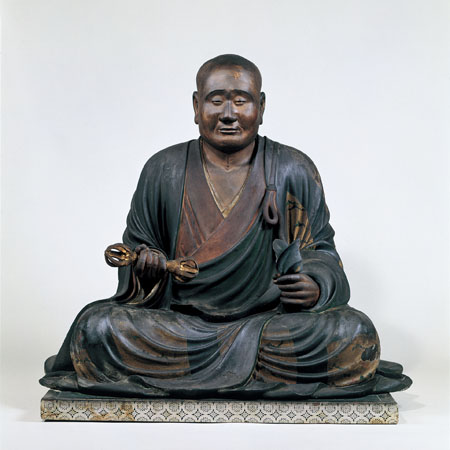
By Yoshino ukyō Tanehisa
Edo period, dated Enpō 2 (1674)
【To be shown over an entire period】
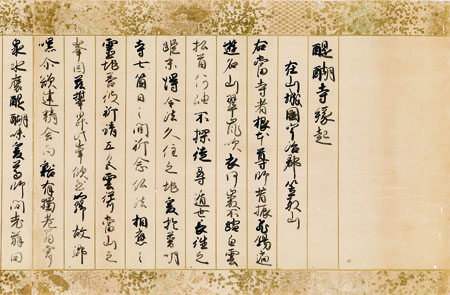
In the hand of Jōjun
Edo period, 17th century
(Picture provided by Nara National Museum, Photo by Kyosuke Sasaki)
【To be shown over an entire period】
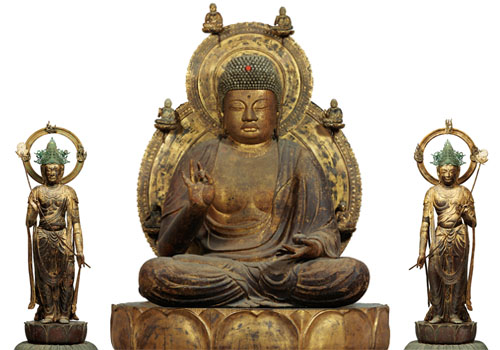
Heian period, 10th century
(Picture provided by Nara National Museum, Photo by Kyosuke Sasaki)
【To be shown over an entire period】
Section 2
The Study and Practice
of the Shingon Mikkyō Tradition of Esoteric Buddhism
Daigoji emphasizes the practice of prayers for spiritual empowerment and esoteric rites or ceremonies, which captivated the hearts and minds of generations of emperors and aristocrats with their miraculous efficacy. The temple became a center of the Ono tradition, one of the two major branches of the Mantra School of Esoteric Buddhism, called Shingon Mikkyō in Japanese. Many monks were drawn to Daigoji, which was seen as a fundamental site of ritual practice. As a result, sculpture and paintings that were indispensible as the chief objects of worship in esoteric rituals, ritual implements, and procedural manuals as well as documents recording those rites and other sacred writings accumulated there in great numbers.
The many temple treasures that are preserved to this day demonstrate the continuity, extending more than one thousand years, of the esoteric rites that were conducted by Daigoji in response to the heartfelt desires of the faithful.
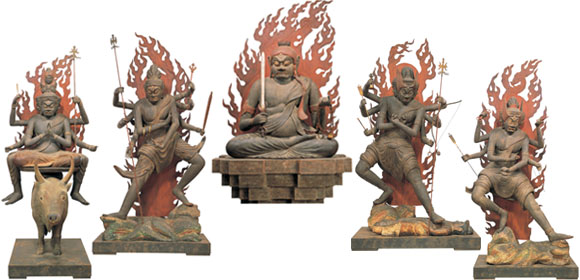
Heian period, 10th century
【To be shown over an entire period】

Kamakura period, 12th–13th century
(Picture provided by Nara National Museum, Photo by Kyosuke Sasaki)
【To be shown between Sep. 19 and Oct. 15】
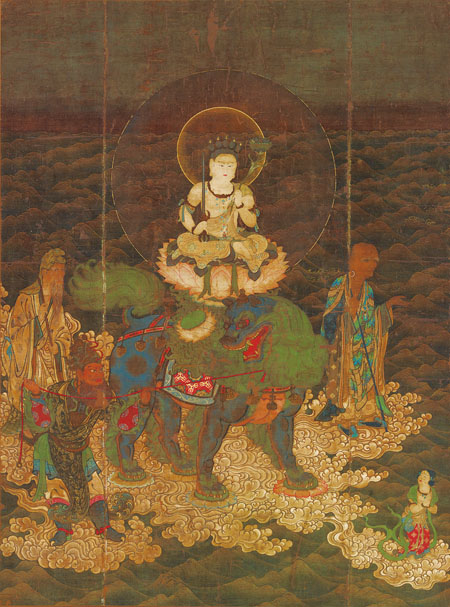
Kamakura period, 13th century
(Picture provided by Nara National Museum, Photo by Kyosuke Sasaki)
【To be shown between Oct. 17 and Nov. 11】
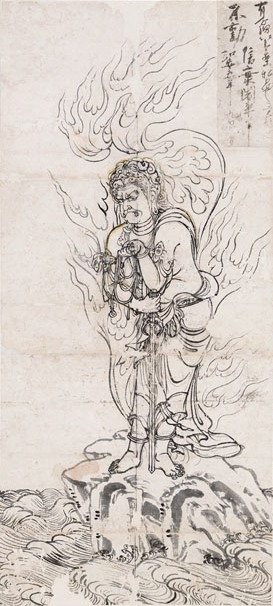
By Shinkai
Kamakura period, dated Kōan 5 (1282)
(Picture provided by Nara National Museum, Photo by Kyosuke Sasaki)
【To be shown between Oct. 17 and Nov. 11】
Section 3
Transmitting the Dharma Lineage:
Links with Political Power
As these esoteric rites were performed with increasing frequency, variations in ritual procedures for the rites sprung up among the monks, and these subtle differences characterized the differing lineages that were created within Daigoji itself. Among these is the Sanbō-in lineage centered at the Sanbō-in cloister, which was founded by the 14th abbot of Daigoji, Shōkaku (1057-1129). Many of the chief monks who headed the Sanbō-in were to become abbots of Daigoji. The temple was able to flourish as the abbots won the faith and favor of powerful figures as seen with Kenshun (1299-1357) who won the backing of the Shōgun Ashikaga Takauji and of Mansai (1378-1435), who received the support from three shōguns including Ashikaga Yoshimitsu.
The history of the transmission of the dharma lineages from one master to the next and their subsequent flourishing can be traced through the documents and writings preserved at Daigoji.
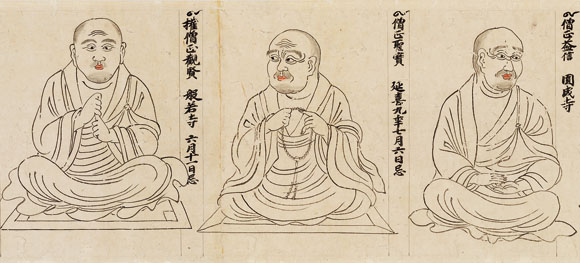
Kamakura period, 14th century
(Picture provided by Nara National Museum, Photo by Kyosuke Sasaki)
【To be shown between Sep. 19 and Oct. 15】
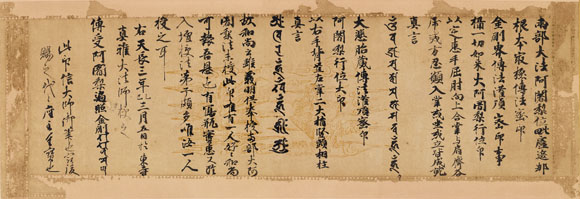
In the hand of Emperor Go-Daigo
Nanbokuchō period, dated Engen 4 (1339)
(Picture provided by Nara National Museum, Photo by Kyosuke Sasaki)
【To be shown between Sep. 19 and Oct. 8】
Section 4
Gien and the Re-building of Daigoji
In the latter half of the 16th century, Gien (1558-1626), the 80th abbot of Daigoji, secured the protection of Toyotomi Hideyoshi, the military leader who unified Japan, as well as other powerful figures. Gien promoted the rebuilding of the temple precincts, which had been ravaged by warfare. The Daigo cherry-blossom viewing party hosted by Hideyoshi in the spring of 1598 (Keichō 3) is widely understood as symbolic of the extravagant beauty of Azuchi-Momoyama-period culture. Gien, moreover, carried out the reorganization of the vast number of documents and sacred writings preserved at Daigoji. His diary, the Gien jugō nikki (Journal of the Abbot Gien Jugō), clearly documents the important role played by Gien and Daigoji in Kyoto during the turbulent era at the start of the early-modern period. The mural-like, sliding-door paintings rendered in gold and silver in the formal reception room of the Sanbō-in, which was constructed in the Keichō era, and the folding-screens painted by masters of various schools such as Tawaraya Sōtatsu convincingly recount the flourishing of Daigoji during the period.
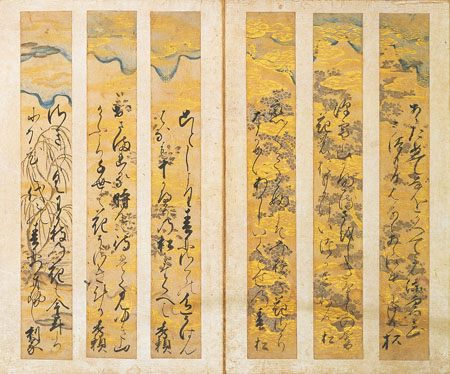
Azuchi-Momoyama period, dated Keichō 3 (1598)
【To be shown over an entire period】
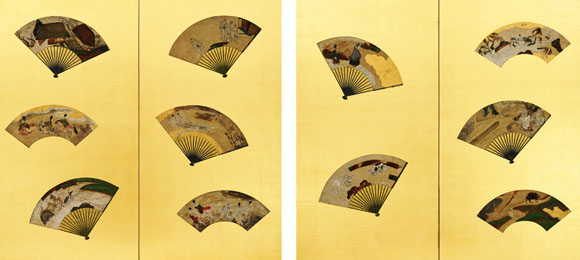
By Tawaraya Sōtatsu
Edo period, 17th century
(Picture provided by Nara National Museum, Photo by Kyosuke Sasaki)
【To be shown between Sep. 19 and Oct. 15】
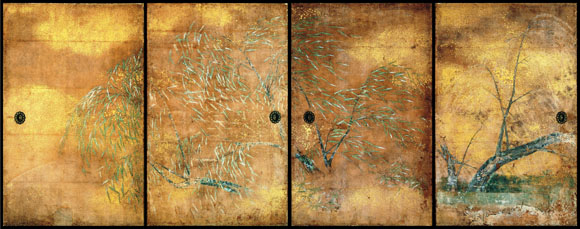
Azuchi-Momoyama to Edo period, 16th–17th century
【To be shown over an entire period】
*All the works are from the collection of DAIGOJI Temple.
*Unauthorized reproduction or use of texts or images from this site is prohibited.
2024 January
- Exhibition
- Closed
- Tea Ceremony
- Mon
- Tue
- Wed
- Thu
- Fri
- Sat
- Sun
- 1
- 2
- 3
- 4
- 5
- 6
- 7
- 8
- 9
- 10
- 11
- 12
- 13
- 14
- 15
- 16
- 17
- 18
- 19
- 20
- 21
- 22
- 23
- 24
- 25
- 26
- 27
- 28
- 29
- 30
- 31
2024 February
- Exhibition
- Closed
- Tea Ceremony
- Mon
- Tue
- Wed
- Thu
- Fri
- Sat
- Sun
- 1
- 2
- 3
- 4
- 5
- 6
- 7
- 8
- 9
- 10
- 11
- 12
- 13
- 14
- 15
- 16
- 17
- 18
- 19
- 20
- 21
- 22
- 23
- 24
- 25
- 26
- 27
- 28
- 29
2024 March
- Exhibition
- Closed
- Tea Ceremony
- Mon
- Tue
- Wed
- Thu
- Fri
- Sat
- Sun
- 1
- 2
- 3
- 4
- 5
- 6
- 7
- 8
- 9
- 10
- 11
- 12
- 13
- 14
- 15
- 16
- 17
- 18
- 19
- 20
- 21
- 22
- 23
- 24
- 25
- 26
- 27
- 28
- 29
- 30
- 31
2024 April
- Exhibition
- Closed
- Tea Ceremony
- Mon
- Tue
- Wed
- Thu
- Fri
- Sat
- Sun
- 1
- 2
- 3
- 4
- 5
- 6
- 7
- 8
- 9
- 10
- 11
- 12
- 13
- 14
- 15
- 16
- 17
- 18
- 19
- 20
- 21
- 22
- 23
- 24
- 25
- 26
- 27
- 28
- 29
- 30
2024 May
- Exhibition
- Closed
- Tea Ceremony
- Mon
- Tue
- Wed
- Thu
- Fri
- Sat
- Sun
- 1
- 2
- 3
- 4
- 5
- 6
- 7
- 8
- 9
- 10
- 11
- 12
- 13
- 14
- 15
- 16
- 17
- 18
- 19
- 20
- 21
- 22
- 23
- 24
- 25
- 26
- 27
- 28
- 29
- 30
- 31
2024 June
- Exhibition
- Closed
- Tea Ceremony
- Mon
- Tue
- Wed
- Thu
- Fri
- Sat
- Sun
- 1
- 2
- 3
- 4
- 5
- 6
- 7
- 8
- 9
- 10
- 11
- 12
- 13
- 14
- 15
- 16
- 17
- 18
- 19
- 20
- 21
- 22
- 23
- 24
- 25
- 26
- 27
- 28
- 29
- 30
2024 July
- Exhibition
- Closed
- Tea Ceremony
- Mon
- Tue
- Wed
- Thu
- Fri
- Sat
- Sun
- 1
- 2
- 3
- 4
- 5
- 6
- 7
- 8
- 9
- 10
- 11
- 12
- 13
- 14
- 15
- 16
- 17
- 18
- 19
- 20
- 21
- 22
- 23
- 24
- 25
- 26
- 27
- 28
- 29
- 30
- 31
2024 August
- Exhibition
- Closed
- Tea Ceremony
- Mon
- Tue
- Wed
- Thu
- Fri
- Sat
- Sun
- 1
- 2
- 3
- 4
- 5
- 6
- 7
- 8
- 9
- 10
- 11
- 12
- 13
- 14
- 15
- 16
- 17
- 18
- 19
- 20
- 21
- 22
- 23
- 24
- 25
- 26
- 27
- 28
- 29
- 30
- 31
2024 September
- Exhibition
- Closed
- Tea Ceremony
- Mon
- Tue
- Wed
- Thu
- Fri
- Sat
- Sun
- 1
- 2
- 3
- 4
- 5
- 6
- 7
- 8
- 9
- 10
- 11
- 12
- 13
- 14
- 15
- 16
- 17
- 18
- 19
- 20
- 21
- 22
- 23
- 24
- 25
- 26
- 27
- 28
- 29
- 30
2024 October
- Exhibition
- Closed
- Tea Ceremony
- Mon
- Tue
- Wed
- Thu
- Fri
- Sat
- Sun
- 1
- 2
- 3
- 4
- 5
- 6
- 7
- 8
- 9
- 10
- 11
- 12
- 13
- 14
- 15
- 16
- 17
- 18
- 19
- 20
- 21
- 22
- 23
- 24
- 25
- 26
- 27
- 28
- 29
- 30
- 31
2024 November
- Exhibition
- Closed
- Tea Ceremony
- Mon
- Tue
- Wed
- Thu
- Fri
- Sat
- Sun
- 1
- 2
- 3
- 4
- 5
- 6
- 7
- 8
- 9
- 10
- 11
- 12
- 13
- 14
- 15
- 16
- 17
- 18
- 19
- 20
- 21
- 22
- 23
- 24
- 25
- 26
- 27
- 28
- 29
- 30
2024 December
- Exhibition
- Closed
- Tea Ceremony
- Mon
- Tue
- Wed
- Thu
- Fri
- Sat
- Sun
- 1
- 2
- 3
- 4
- 5
- 6
- 7
- 8
- 9
- 10
- 11
- 12
- 13
- 14
- 15
- 16
- 17
- 18
- 19
- 20
- 21
- 22
- 23
- 24
- 25
- 26
- 27
- 28
- 29
- 30
- 31
2025 January
- Exhibition
- Closed
- Tea Ceremony
- Mon
- Tue
- Wed
- Thu
- Fri
- Sat
- Sun
- 1
- 2
- 3
- 4
- 5
- 6
- 7
- 8
- 9
- 10
- 11
- 12
- 13
- 14
- 15
- 16
- 17
- 18
- 19
- 20
- 21
- 22
- 23
- 24
- 25
- 26
- 27
- 28
- 29
- 30
- 31
2025 February
- Exhibition
- Closed
- Tea Ceremony
- Mon
- Tue
- Wed
- Thu
- Fri
- Sat
- Sun
- 1
- 2
- 3
- 4
- 5
- 6
- 7
- 8
- 9
- 10
- 11
- 12
- 13
- 14
- 15
- 16
- 17
- 18
- 19
- 20
- 21
- 22
- 23
- 24
- 25
- 26
- 27
- 28
2025 March
- Exhibition
- Closed
- Tea Ceremony
- Mon
- Tue
- Wed
- Thu
- Fri
- Sat
- Sun
- 1
- 2
- 3
- 4
- 5
- 6
- 7
- 8
- 9
- 10
- 11
- 12
- 13
- 14
- 15
- 16
- 17
- 18
- 19
- 20
- 21
- 22
- 23
- 24
- 25
- 26
- 27
- 28
- 29
- 30
- 31
2025 April
- Exhibition
- Closed
- Tea Ceremony
- Mon
- Tue
- Wed
- Thu
- Fri
- Sat
- Sun
- 1
- 2
- 3
- 4
- 5
- 6
- 7
- 8
- 9
- 10
- 11
- 12
- 13
- 14
- 15
- 16
- 17
- 18
- 19
- 20
- 21
- 22
- 23
- 24
- 25
- 26
- 27
- 28
- 29
- 30
2025 May
- Exhibition
- Closed
- Tea Ceremony
- Mon
- Tue
- Wed
- Thu
- Fri
- Sat
- Sun
- 1
- 2
- 3
- 4
- 5
- 6
- 7
- 8
- 9
- 10
- 11
- 12
- 13
- 14
- 15
- 16
- 17
- 18
- 19
- 20
- 21
- 22
- 23
- 24
- 25
- 26
- 27
- 28
- 29
- 30
- 31
2025 June
- Exhibition
- Closed
- Tea Ceremony
- Mon
- Tue
- Wed
- Thu
- Fri
- Sat
- Sun
- 1
- 2
- 3
- 4
- 5
- 6
- 7
- 8
- 9
- 10
- 11
- 12
- 13
- 14
- 15
- 16
- 17
- 18
- 19
- 20
- 21
- 22
- 23
- 24
- 25
- 26
- 27
- 28
- 29
- 30
2025 July
- Exhibition
- Closed
- Tea Ceremony
- Mon
- Tue
- Wed
- Thu
- Fri
- Sat
- Sun
- 1
- 2
- 3
- 4
- 5
- 6
- 7
- 8
- 9
- 10
- 11
- 12
- 13
- 14
- 15
- 16
- 17
- 18
- 19
- 20
- 21
- 22
- 23
- 24
- 25
- 26
- 27
- 28
- 29
- 30
- 31
2025 August
- Exhibition
- Closed
- Tea Ceremony
- Mon
- Tue
- Wed
- Thu
- Fri
- Sat
- Sun
- 1
- 2
- 3
- 4
- 5
- 6
- 7
- 8
- 9
- 10
- 11
- 12
- 13
- 14
- 15
- 16
- 17
- 18
- 19
- 20
- 21
- 22
- 23
- 24
- 25
- 26
- 27
- 28
- 29
- 30
- 31
2025 September
- Exhibition
- Closed
- Tea Ceremony
- Mon
- Tue
- Wed
- Thu
- Fri
- Sat
- Sun
- 1
- 2
- 3
- 4
- 5
- 6
- 7
- 8
- 9
- 10
- 11
- 12
- 13
- 14
- 15
- 16
- 17
- 18
- 19
- 20
- 21
- 22
- 23
- 24
- 25
- 26
- 27
- 28
- 29
- 30
2025 October
- Exhibition
- Closed
- Tea Ceremony
- Mon
- Tue
- Wed
- Thu
- Fri
- Sat
- Sun
- 1
- 2
- 3
- 4
- 5
- 6
- 7
- 8
- 9
- 10
- 11
- 12
- 13
- 14
- 15
- 16
- 17
- 18
- 19
- 20
- 21
- 22
- 23
- 24
- 25
- 26
- 27
- 28
- 29
- 30
- 31
2025 November
- Exhibition
- Closed
- Tea Ceremony
- Mon
- Tue
- Wed
- Thu
- Fri
- Sat
- Sun
- 1
- 2
- 3
- 4
- 5
- 6
- 7
- 8
- 9
- 10
- 11
- 12
- 13
- 14
- 15
- 16
- 17
- 18
- 19
- 20
- 21
- 22
- 23
- 24
- 25
- 26
- 27
- 28
- 29
- 30
2025 December
- Exhibition
- Closed
- Tea Ceremony
- Mon
- Tue
- Wed
- Thu
- Fri
- Sat
- Sun
- 1
- 2
- 3
- 4
- 5
- 6
- 7
- 8
- 9
- 10
- 11
- 12
- 13
- 14
- 15
- 16
- 17
- 18
- 19
- 20
- 21
- 22
- 23
- 24
- 25
- 26
- 27
- 28
- 29
- 30
- 31
